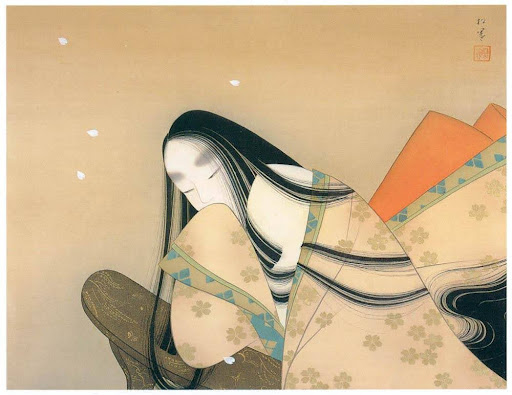11.小町の図
(Portrait of Komachi)
日本女性の美と精神性を象徴する作品

《小町の図》は、1912〜1926年に制作したとされる作品。平安時代の歌人・小野小町を題材にした美人画である。松園は古典文学や謡曲に登場する女性像を多く描いており、長い黒髪を垂らし、伏し目がちで静かに佇む女性像は、晩年の小町を思わせる憂いと気品を湛えている。目を閉じた表情は、内面の静けさや過去への回想を感じさせる。着物には花文様や幾何学模様が施され、白い花びらが舞う背景は、儚さや老いの象徴としても解釈される。背景を抑え、人物を中心に据えることで、視線を自然と女性の表情に導く構成となっている。理想化された美しさだけでなく、老い・孤独・回想といった人間的な側面を含んでおり、深い余韻を残す作品である。
Portrait of Komachi
A symbolic depiction of Japanese feminine beauty and spirituality
Believed to have been painted between 1912 and 1926, Portrait of Komachi is a bijin-ga (portrait of a beautiful woman) inspired by Ono no Komachi, a celebrated poet of the Heian period. Uemura frequently portrayed women from classical literature and Yōkyoku, and here she presents a figure with long, flowing black hair, downcast eyes, and a quiet, contemplative posture—evoking the melancholy grace of Komachi in her later years.
The woman’s closed eyes suggest inner tranquility and a reflective gaze toward the past. Her kimono is adorned with floral and geometric patterns, while the background, scattered with white petals, can be interpreted as symbols of transience and aging. By minimizing the background and placing the figure at the center, Uemura draws the viewer’s attention naturally to the woman’s expression.
This work captures not only idealized beauty, but also human elements such as aging, solitude, and remembrance, leaving a lingering emotional resonance.
お問い合わせ
〒154-0024 東京都世田谷区三軒茶屋1-39-7